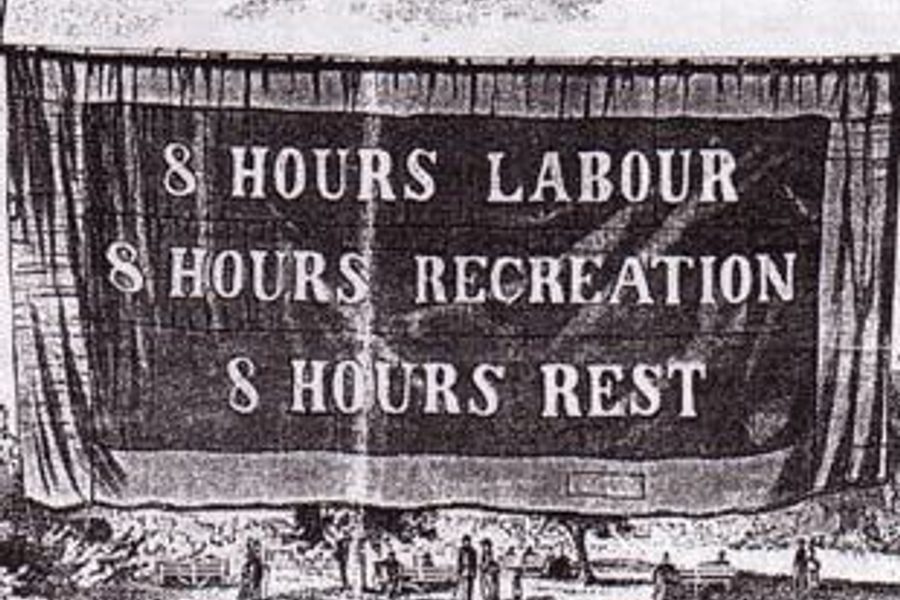What Vacation Days?
Despite being one of the richest nations, America denies its workers mandated paid vacations and sick days
David Moberg

Last year Mary Lou Eckart took her first vacation in five years, a trip from her home in Decatur, Ill., to see her grandchildren in Florida. But the Illinois state government, which pays her to care for a severely disabled teenage girl, provides her no paid vacation time. So Eckart took the girl – and her work – with her.
She faces a similar bind if she gets sick. “I just had an incident two weeks ago,” she says. “I had an inner ear infection that I didn’t know about, and I passed out. My 17-year-old daughter covered for me while I recovered. I get no paid vacation, no time off, no sick leave. But if they put these clients in a nursing home, I know that is very expensive. I’d love to have a vacation. I’d love to be able to get away. I’d love to have someone fill in for me. I feel like we deserve more than what we’re getting.”
Eckart’s story is all too common: Nearly one-fourth of American workers have no paid vacation or holidays, according to a recent study from the D.C.-based Center for Economic and Policy Research (CEPR), and nearly half of all private sector workers have no paid sick days. But if Eckart were living in any other industrialized country, she would be legally guaranteed at least two weeks paid vacation and – in 136 countries – from seven to more than 30 paid sick days. The United States is the only rich country that does not mandate paid vacations and paid sick days, and Americans who are afforded such benefits enjoy far less time off than workers in other wealthy nations.
Americans now work more every year, on average, than workers in any other industrialized country (except for a virtual tie with New Zealand). With women working longer hours each year, the average annual work time for a married couple is growing steadily, and family time – including the crucial bonding experience of vacations – has suffered. Full-time workers in much of Europe typically take seven to eight weeks of vacation and holidays each year – that’s double the American average for full-time workers. Overall, the average private sector worker in the United States gets about nine paid vacation days and six paid holidays each year. Low-paid, part-time or small-business workers typically get far fewer, sometimes none. The same holds for paid sick leave: 72 percent of the highest-paid quarter of private sector workers get paid sick days compared to only 21 percent of workers in the lowest-paid quarter.
Intercontinental disparity
Why do workers in other rich countries have more paid time off? Mainly because laws demand employers provide it. The European Union requires its members to set a minimum standard of four weeks paid vacation (covering part-time workers as well). Finland and France require six weeks paid vacation, plus additional paid holidays. Most countries require workers to take the time off and employers to give them vacation at convenient times. Some governments even require employers to pay bonuses so workers can afford to do more than sit at home on vacation. On top of that, unions in Europe and other rich industrialized countries – whose contracts cover up to 90 percent of the workforce – typically negotiate additional time off. Meanwhile, the standard workweek is slightly shorter in many European countries, and workers retire earlier with better public pensions.
Until the early ’70s, European and American workers logged similar hours. But the pattern then drastically diverged, with Europeans getting more vacation time, around the same time that U.S. income inequality began growing. In the United States, corporations gained the upper hand against workers and their declining unions, and the Democratic Party started shifting away from working class concerns. In Europe, stronger unions and left political parties pushed for shorter work hours. In some cases, as jobs were lost when traditional industries restructured or work was outsourced, unions saw reduced work time as a way to share work. But more often, unions were continuing the battle to share wealth in the form of more leisure, which had started a century earlier with the movement for an eight-hour day – the goal of Chicago protestors in May, 1886, that ended in the Haymarket Massacre, repression of the labor movement, and creation of May 1 as the international workers’ holiday.
The difference in work hours between the United States and most industrial countries “is exactly a manifestation of the same forces driving broader inequality,” says CEPR economist John Schmitt, pointing to deterioration of the minimum wage, pensions, public services, health insurance and wages under pressure from globalization, deregulation, privatization and attacks on unions. “Workers haven’t been able to translate higher productivity gains into higher pay or benefits, and they’ve been unable to address the time crunch.”
“People in the United States don’t even understand what could be possible on this issue [of paid time off],” Schmitt says. “This is one of the most important ideological victories of the right in the last 30 years – to persuade us we aren’t rich enough to treat workers well. We’re incredibly rich, getting richer every year, and we have plenty of resources to pay adequate wages, pensions, health insurance and vacations, but we’ve chosen to give that money to the top five percent.”
European and other industrialized countries have divided their growing ability to produce differently. For example, Europe has nearly caught up with – and many countries have pulled ahead of – the United States in labor productivity (the output from each hour of work), the key measure of an economy’s potential.
In recent years, however, American workers have rapidly increased the amount of goods and services they produce each year, in comparison to Europe. These two measurements have largely diverged because Europeans have been enjoying more time away from the job, just as they’ve been enjoying a more egalitarian society.
According to Harvard economist Alberto Alesina, Europeans are happier, and have less stress and insecurity, which is good for health and longevity. Studies in the United States, for example, indicate that taking vacations cuts in half the risk of heart attacks for men. Longer, mandated vacations haven’t undercut the competitiveness of other rich countries, and there’s evidence that they increase labor productivity.
Plus, recent increases in the U.S. gross domestic product haven’t significantly helped most Americans: The super-rich have captured most of the income gains. An accurate calculation of the gross domestic product – subtracting such costs as crime, environmental depredations, militarism and declining social trust – would actually show that growth in economic output has brought few, if any, real gains in welfare for American society. Indeed, CEPR economists David Rosnick and Mark Weisbrot argue that Europe’s shorter work hours help the environment by reducing energy consumption and carbon emissions.
Taking back time
Most Americans would be better off with more paid vacation and leave, but inequality, insecurity and the competitive rat race drives people to work even harder, often just to keep their heads above water. It’s very difficult for individuals to demand more time, even if the limited polling available suggests it would be popular. Major gains will only come from an organized movement and changed laws. One organization, Take Back Your Time, founded by writer and documentary filmmaker John de Graaf, is trying to persuade presidential candidates to support its proposal for mandating three weeks of paid vacation for all workers. “I think the political figure who would pick up on this issue would find great resonance,” De Graaf says, but so far nobody has.
At this point, more modest proposals have a better chance to succeed. Sen. Ted Kennedy (D-Mass.) and Rep. Rosa DeLauro (D-Conn.) have introduced the Healthy Families Act, which would guarantee seven days of paid leave for all workers to deal with their own or a family member’s illness. Beyond the obvious help to the individuals who need care, such legislation would help businesses economically. Rather than putting in an unproductive day at work spreading communicable diseases (or sending their sick child to spread illness at a child care center), workers could just stay at home, and it would reduce the employee turnover that results from workers taking off unauthorized, unpaid sick days. Five states have mandatory temporary disability insurance programs to cover income losses from short illnesses, and last November, San Francisco voters approved the first mandated paid sick days in the United States. The Working Families Party in New York is now campaigning for paid leave for new parents and adults caring for ailing relatives, a protection California passed in 2004 (thus strengthening the unpaid family and medical leave federal law provides).
Mandated paid sick days would help workers like Elnora Collins, a home care worker in Chicago. “If you get sick, you go to work sick. If you show up for work, you endanger your patients. If you don’t show up for work, you get no pay. I recently lost a whole day’s pay, because I ended up in a hospital for an overnight stay. It was an anxiety attack, like a heart attack. It’s very frightening. And then, when you look at that paycheck, you really cry.”
Compare the work time and leisure in the United States to that in other rich countries, and we all have good reason to share in her tears.
David Moberg, a former senior editor of In These Times, was on staff with the magazine from when it began publishing in 1976 until his passing in July 2022. Before joining In These Times, he completed his work for a Ph.D. in anthropology at the University of Chicago and worked for Newsweek. He received fellowships from the John D. and Catherine T. MacArthur Foundation and the Nation Institute for research on the new global economy.









